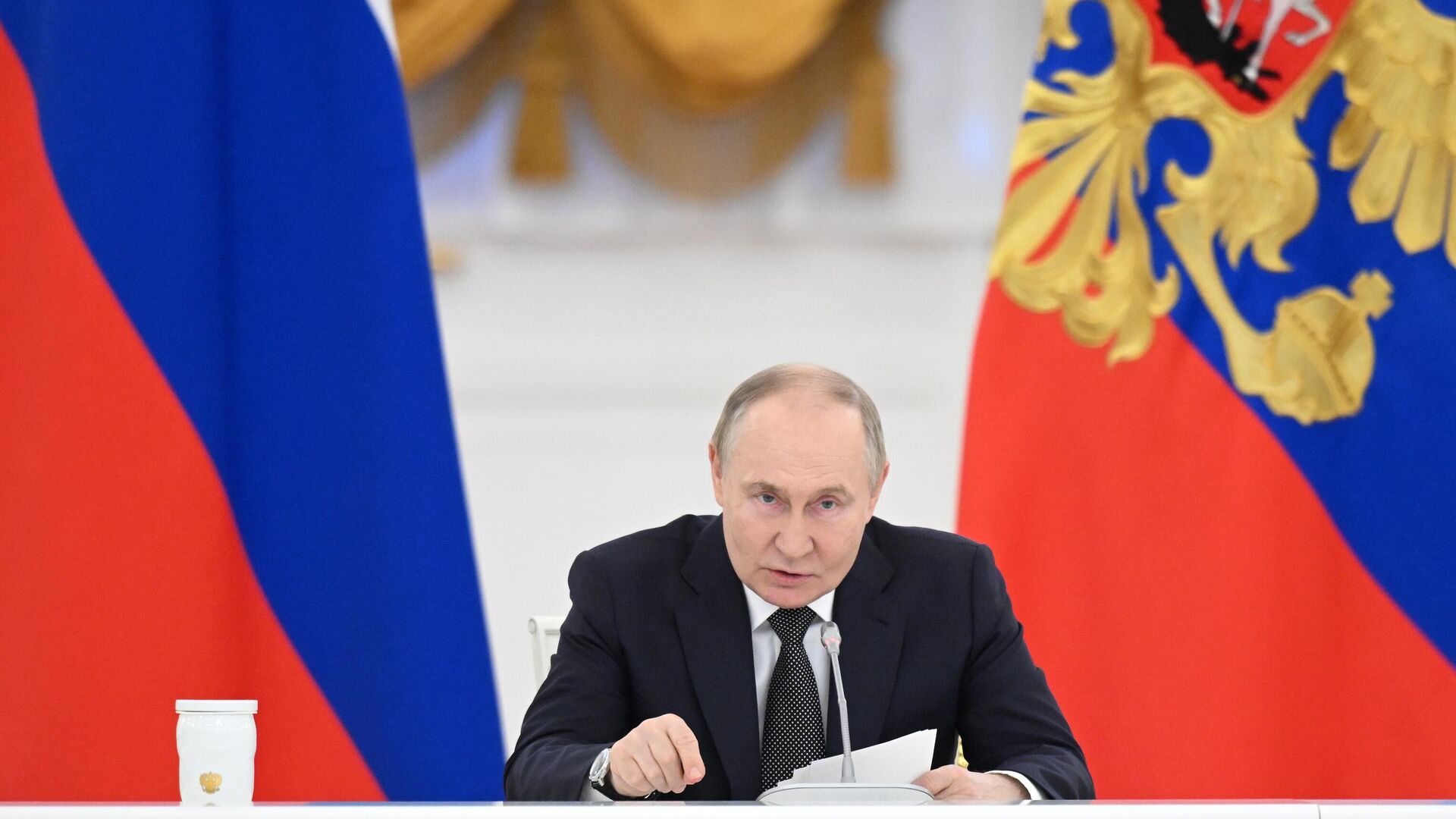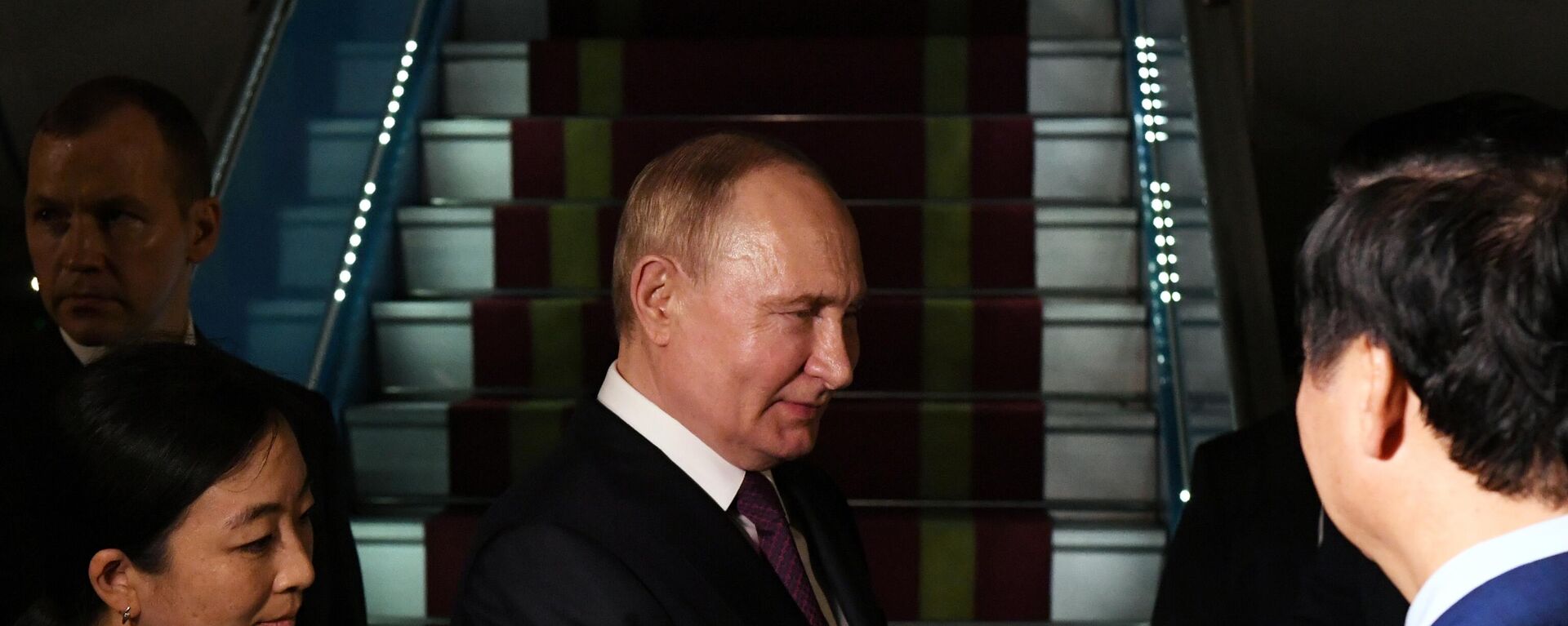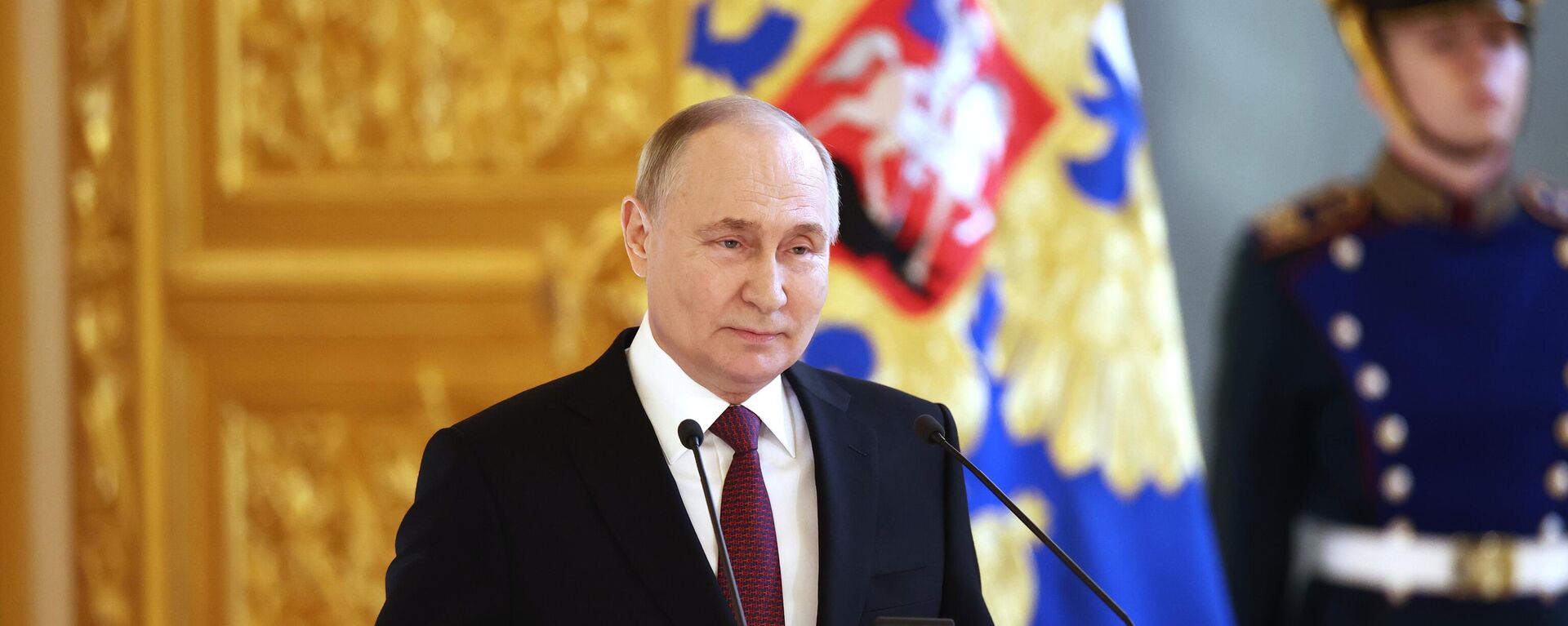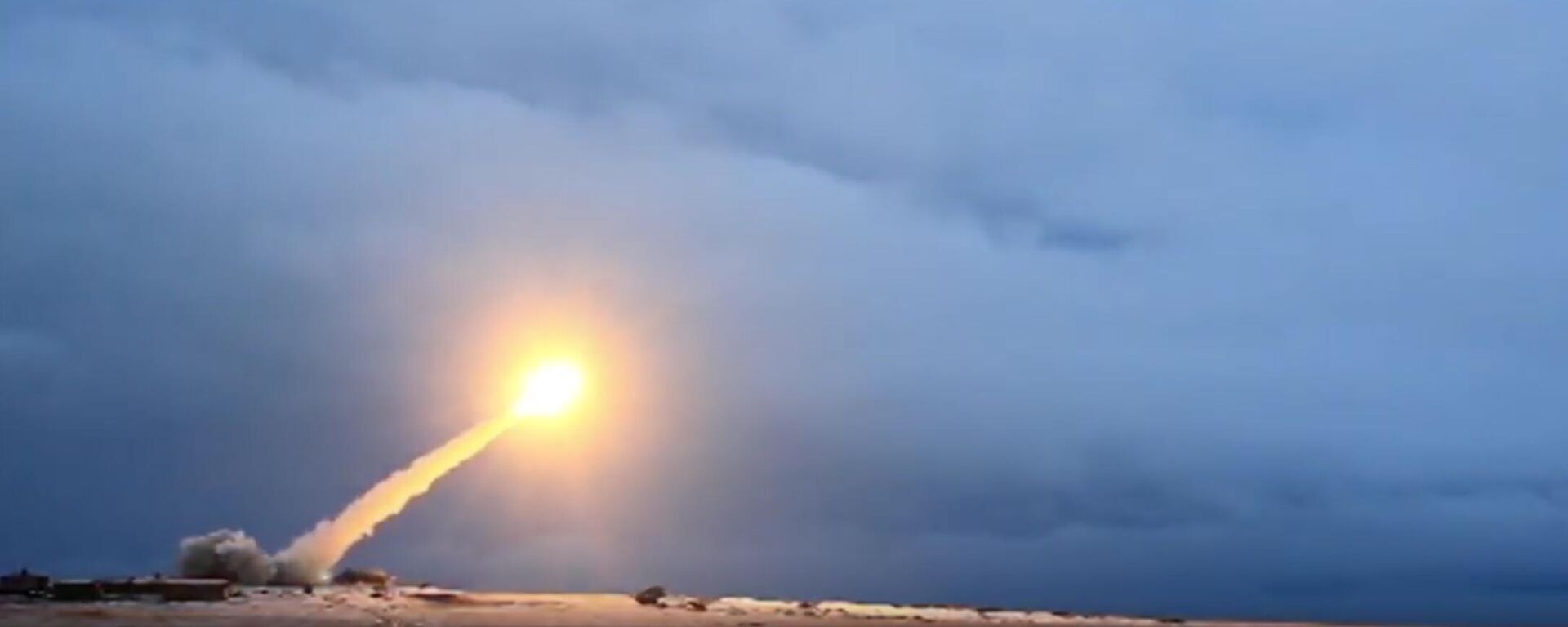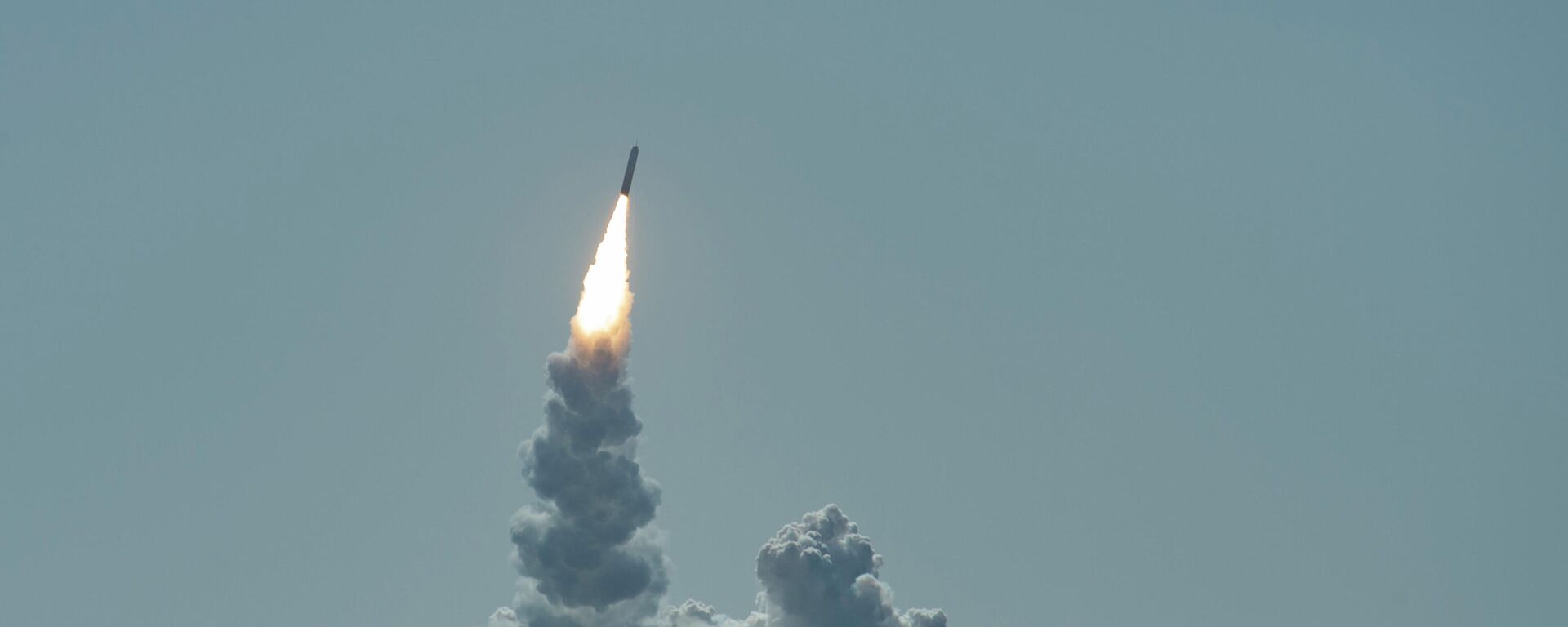https://sputnikglobe.com/20240621/putin-sends-clear-message-to-nato-by-revising-russian-nuclear-doctrine-1119050537.html
Putin Sends Clear Message to NATO By Revising Russian Nuclear Doctrine
Putin Sends Clear Message to NATO By Revising Russian Nuclear Doctrine
Sputnik International
Moscow has signaled that it is ready to adapt its nuclear doctrine to emerging geopolitical challenges. What changes could be made?
2024-06-21T16:13+0000
2024-06-21T16:13+0000
2024-06-22T04:57+0000
russia
vladimir putin
russian federation
moscow
nato
nuclear-armed sea-launched cruise missile (slcm)
national defense authorization act (ndaa)
nuclear warheads
nuclear weapons
analysis
https://cdn1.img.sputnikglobe.com/img/07e8/06/15/1119051259_0:330:3054:2048_1920x0_80_0_0_b1a80d55dab8f7aa7c8e0a45b9dd1310.jpg
Russian President Vladimir Putin announced plans for the further development of the Russian nuclear triad to guarantee strategic deterrence and ensure the balance of power in the world at a June 21 meeting with graduates of higher military educational institutions.Earlier, at a press conference in Vietnam, the Russian president noted that Moscow is considering possible changes to its national nuclear doctrine due to the West's attempts to lower the threshold for the use of nuclear weapons. Putin particularly referred to Western military experts discussing the idea of a limited use of low-yield nuclear arms.The president specified that Russia is not planning to include a preemptive nuclear strike in its doctrine, because the enemy would be definitely destroyed by a retaliatory attack.Putin is sending a clear message to the West, according to Dmitry Kornev, the founder of the Military Russia portal. However, he doesn't expect dramatic changes to the Russian nuclear policy.There are four conditions determining the possibility for Russia's use of nuclear weapons, according to the Fundamentals of Nuclear Deterrence State Policy, which was published on June 2, 2020:It is no secret that low-yield nuclear weapons already exist, according to retired Lieutenant-General Yevgeny Buzhinsky, chairman of PIR-Center think tank's executive board and professor at the Higher School of Economics.Buzhinsky added that he doesn't see any merit in "miniaturizing" nuclear arms.The retired lieutenant general pointed out that the Trump administration was mulling equipping cruise missiles with low-yield nuclear warheads in 2018. Team Trump argued that it would provide the US with "a needed non-strategic regional presence" that would address "the increasing need for flexible and low-yield options" overseas.In particular, the US considered the production of nuclear-armed sea-launched cruise missiles (SLCM-N) and placing them on attack submarines deployed in the North Atlantic and Asia Pacific.The SLCM-N project was axed by the Biden administration in 2022 but most recently revived within the framework of the National Defense Authorization Act for fiscal year 2024 under the pretext of Russia's special military operation and China's alleged plans to "invade" the island of Taiwan.American proponents of low-yield nuclear weapons suggested that their use could not lead to an all-out nuclear retaliation due to their limited impact."If conflict crosses the nuclear threshold, lower yields would signal a clear interest in limiting its intensity," claimed Lieutenant Commander Alan Cummings, US Navy Reserve, in his op-ed for US Naval Institute in April.According to Kornev, there should be no illusions about limited nuclear strikes.Russia has repeatedly warned the US against lowering the nuclear threshold. In 2020, Russian Foreign Ministry spokeswoman Maria Zakharova pointed out that "those who like to theorize about the flexibility of American nuclear potential must understand that in line with the Russian military doctrine such actions are seen as warranting retaliatory use of nuclear weapons by Russia."
https://sputnikglobe.com/20240620/russia-thinking-about-possible-changes-to-its-nuclear-doctrine---putin-1119037397.html
https://sputnikglobe.com/20240621/putin-announces-plans-for-further-development-of-nuclear-triad-1119048735.html
https://sputnikglobe.com/20240529/how-us-is-flirting-with-idea-of-limited-nuclear-conflict-with-russia-and-china-1118682784.html
https://sputnikglobe.com/20240621/us-open-to-nuclear-risks-talks-with-russia-without-tying-issue-to-ukraine-conflict---nsc-1119043108.html
russia
russian federation
moscow
Sputnik International
feedback@sputniknews.com
+74956456601
MIA „Rossiya Segodnya“
2024
News
en_EN
Sputnik International
feedback@sputniknews.com
+74956456601
MIA „Rossiya Segodnya“
Sputnik International
feedback@sputniknews.com
+74956456601
MIA „Rossiya Segodnya“
russian nuclear doctrine, vladimir putin, preemptive strike, us low-yield nuclear weapons, us nuclear doctrine, us lowering the threshold for the use of nuclear weapons, limited nuclear strike
russian nuclear doctrine, vladimir putin, preemptive strike, us low-yield nuclear weapons, us nuclear doctrine, us lowering the threshold for the use of nuclear weapons, limited nuclear strike
Putin Sends Clear Message to NATO By Revising Russian Nuclear Doctrine
16:13 GMT 21.06.2024 (Updated: 04:57 GMT 22.06.2024) Moscow has signaled that it is ready to adapt its nuclear doctrine to emerging geopolitical challenges. What changes could be made?
Russian President Vladimir Putin
announced plans for the further development of the Russian nuclear triad to guarantee strategic deterrence and ensure the balance of power in the world at a June 21 meeting with graduates of higher military educational institutions.
Earlier, at a press conference in Vietnam, the Russian president noted that Moscow is considering
possible changes to its national nuclear doctrine due to the West's
attempts to lower the threshold for the use of nuclear weapons. Putin particularly referred to Western military experts discussing the idea of a limited use of low-yield nuclear arms.
The president specified that Russia is not planning to include a preemptive nuclear strike in its doctrine, because the enemy would be definitely destroyed by a retaliatory attack.
Putin is sending a clear message to the West, according to Dmitry Kornev, the founder of the Military Russia portal. However, he doesn't expect dramatic changes to the Russian nuclear policy.
"There are no changes related to… strategic nuclear forces, the deployment of nuclear weapons, etc., in the basic documents," Kornev told Sputnik.
There are four conditions determining the possibility for Russia's use of nuclear weapons,
according to the Fundamentals of Nuclear Deterrence State Policy, which was published on June 2, 2020:
receipt of reliable information about the launch of ballistic missiles attacking the territories of the Russian Federation and/or its allies;
the enemy's use of nuclear weapons or other types of weapons of mass destruction on the territories of the Russian Federation and/or its allies;
the adversary is acting against critical Russian government or military installations, which could disrupt the response of Russian nuclear forces;
aggression against the Russian Federation with the use of conventional weapons, when the very existence of the state is threatened.
"A more detailed description of these conditions may most likely follow," Kornev assumed.
It is no secret that low-yield nuclear weapons already exist, according to retired Lieutenant-General Yevgeny Buzhinsky, chairman of PIR-Center think tank's executive board and professor at the Higher School of Economics.
"Low-yield nuclear weapons are those in the range from 0.5 to 50 kilotons," Buzhinsky told Sputnik. "What was dropped on Hiroshima at one time (20 kilotons) could be called a low-yield bomb, according to current definitions."
Buzhinsky added that he doesn't see any merit in "miniaturizing" nuclear arms.
The retired lieutenant general pointed out that the Trump administration was mulling equipping cruise missiles with low-yield nuclear warheads in 2018. Team Trump argued that it would provide the US with "a needed non-strategic regional presence" that would address "the increasing need for flexible and low-yield options" overseas.
In particular, the US considered the production of
nuclear-armed sea-launched cruise missiles (SLCM-N) and placing them on attack submarines deployed in the North Atlantic and Asia Pacific.
The SLCM-N project was axed by the Biden administration in 2022 but most recently revived within the framework of the National Defense Authorization Act for fiscal year 2024 under the pretext of Russia's special military operation and China's alleged plans to "invade" the island of Taiwan.
American proponents of low-yield nuclear weapons suggested that their use could not lead to an all-out nuclear retaliation due to their limited impact.
"If conflict crosses the nuclear threshold, lower yields would signal a clear interest in limiting its intensity," claimed Lieutenant Commander Alan Cummings, US Navy Reserve, in his op-ed for US Naval Institute in April.
According to Kornev, there should be no illusions about limited nuclear strikes.
"Nuclear weapons have no threshold. Everywhere in the world it is believed that the use of nuclear weapons is the use of nuclear weapons, no matter what power, no matter what targets," the pundit emphasized.
Russia has repeatedly warned the US against lowering the nuclear threshold. In 2020, Russian Foreign Ministry spokeswoman Maria Zakharova pointed out that "those who like to theorize about the flexibility of American nuclear potential must understand that in line with the Russian military doctrine such actions are seen as warranting retaliatory use of nuclear weapons by Russia."
